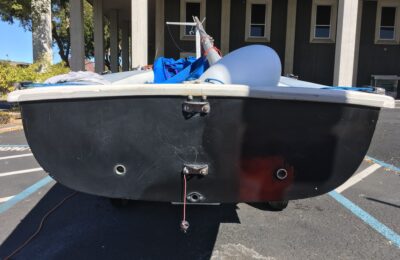Summary
By the internet-testimony of their customers, the companies listed here seem to produce quality products, based on the positive reviews one finds on-line. Prices for a new unit range from $3,500 to $7,500 and up.
Introduction
I wanted to purchase and learn how to use a mechanical wind vane for my boat and, hopefully, trip to Hawaii. I did some research and came up with a list of wind-vane makers that includes Monitor, Aries, Cape Horn, Hydrovane, and Sailomat. My boat, with a gentle reverse transom, should present few complications for manufacturers, as in, I should be able to make any one of them fit. I’m pricing for a wheel-steered 32’ boat.
As far as I understand it, with the exception of the Hydrovane, these servo pendulum vanes work in the same way: A wind flapper/blade is pointed into the wind. When the boat veers off course, the flapper pulls an oar/ blade in the water in one direction which in turn pulls a line attached to one’s tiller or wheel.
One other consideration is if and how the vane can be used or adapted to serve as an emergency rudder.
As an aside, it’s sort of a dubious business proposition in my mind, manufacturing wind vanes. Your product is supposed to be so bulletproof that people’s lives effectively depend on it, and it should last for 50 years. Then you sell it to a market filled with people who try to be clever about buying used products. You compete with yourself for eternity. In any case:
Monitor
https://www.scanmarinternational.com/monitor-windvance-hp
On an Ericson 39
Price is $4,900 for a fixed mounting system for a wheel steered boat. A frame of stainless tubes attach to your transom, holding the pendulum shaft vertically and behind the boat.
The parent company of Monitor is Scanmar, whose contact address is in San Leandro, California, in the San Francisco Bay area. Scanmar sells supplemental emergency rudders that are designed to work with the Monitor wind vane.
This may be the most widely-used windvane.
Aries
https://www.ariesvanegear.com/
Similar in attachment form to the Monitor, but with large cast aluminum components instead of stainless steel, the Monitor mounts off of the rear of a boat to allow the servo-rudder in the water to swing in a vertical plane. The vane blades are constructed of lightweight plywood and expected to snap off in the event of being struck by a large wave.
Originally designed by Englishman Nick Franklin, Aries was subsequently purchased and run from Denmark until 2015 when Lean Nelis, a Dutch businessperson and sailor bought the company.
An Aries vane with a wheel attachment for a non EU buyer costs 3,800 euros plus shipping from the Netherlands.
Cape Horn
https://caphorn.com/en/welcome/
Composed of a single shaft with fewer struts and supports, the mounted Cape Horn vane presents a more elegant framework than the buttressed Monitor or Aries vanes.
Prices start from $3,460 (presumably, in addition to shipping from France)
Hydrovane
https://hydrovane.com/
Canada-based maker. Prices vary, with a selection of components that vary from boat to boat. The Hydrovane is an ‘Auxiliary Rudder Windvane’ system and as the name implies, uses its own rudder to help steer the boat instead of relying on the main rudder.
There is a good (if Hydrovane-slanted) comparison of different types of Wind Vanes on the Hydrovane web site
History/Background
“The Hydrovane is the product of an engineer’s lifetime passion.
Derek Daniels, an engineer from Nottingham, England, was the founder and inventor of the Hydrovane in 1968. He made it his life’s work.
The initial concept was to develop a system better than the standard servo pendulum windvane. Hydrovane and Aries were the first two windvanes on the market in the 60’s. An early Hydrovane was used by Herman Jansen for his solo circumnavigation in 1972. Others followed – notably Leslie Powles, whose remarkable non-stop circumnavigation via the five great southern Capes, confirmed its reliablity. The Hydrovane soon gained recognition in England and Europe for its clever engineering and robustness.”
Sailomat
www.sailomat.com
Sailomat no longer exists. I know about the company because it the vane Christian Williams has used on both of his California-to-Hawaii trips and of which he speaks highly. I have little to add beyond directing a reader to a descriptive video:
https://www.youtube.com/embed/_gEJ3RJYiYc?wmode=opaque&start=0
I completed an enquiry form in November 2019 (pre-Covid) on the Sailomat web site http://www.sailomat.com/contact.php and received back the following note:
Dear customer,
Model SAILOMAT 800 as well as previous models are currently completely sold out. Spare parts still available.
All SAILOMAT deliveries are temporarily suspended as we restructure the company.
Happy sailing
Stellan
S A I L O M A T
SAILOMAT International. SAILOMAT USA.
The Ultimate in Sailboat Self-Steering.
Since 1975. Worldwide delivery.
All-mechanical self-steering systems for sailboats 26- 55 feet LOA
Stellan Knoos, company founder, director: technology, design and manufacturing
Ph.D. aerospace engineering
SAILOMAT 3040, SAILOMAT 500, SAILOMAT 536, SAILOMAT 600,
SAILOMAT 601, SAILOMAT 700, SALOMAT 760, SAILOMAT 800.
Custom designed self-steering systems. Manufactured in USA and Sweden.
New SAILOMAT 800 model, 2016 (upgraded SAILOMAT 760) .
Patents. Trademark. All rights reserved.
Email: contact@sailomat.com
Technical info: www.sailomat.com
San Diego, California, USA



